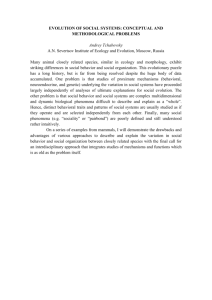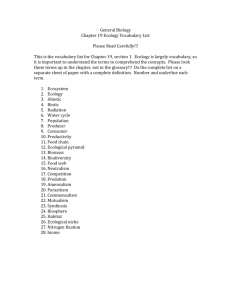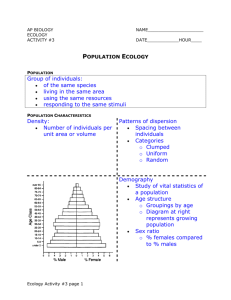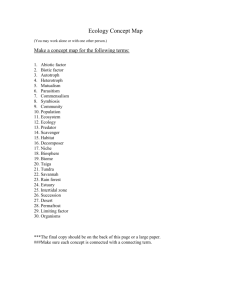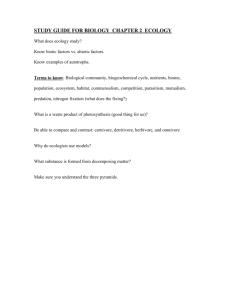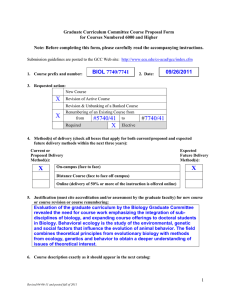SYLLABUS BI508: Behavioral Ecology Spring Semester 2014 Course:
advertisement
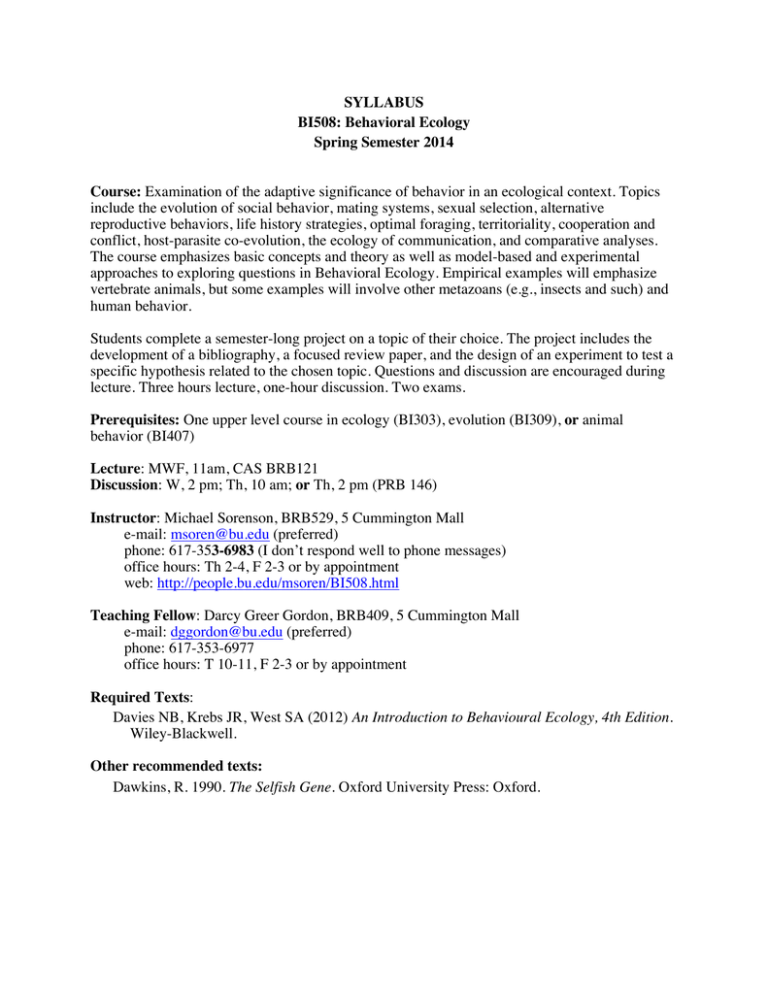
SYLLABUS BI508: Behavioral Ecology Spring Semester 2014 Course: Examination of the adaptive significance of behavior in an ecological context. Topics include the evolution of social behavior, mating systems, sexual selection, alternative reproductive behaviors, life history strategies, optimal foraging, territoriality, cooperation and conflict, host-parasite co-evolution, the ecology of communication, and comparative analyses. The course emphasizes basic concepts and theory as well as model-based and experimental approaches to exploring questions in Behavioral Ecology. Empirical examples will emphasize vertebrate animals, but some examples will involve other metazoans (e.g., insects and such) and human behavior. Students complete a semester-long project on a topic of their choice. The project includes the development of a bibliography, a focused review paper, and the design of an experiment to test a specific hypothesis related to the chosen topic. Questions and discussion are encouraged during lecture. Three hours lecture, one-hour discussion. Two exams. Prerequisites: One upper level course in ecology (BI303), evolution (BI309), or animal behavior (BI407) Lecture: MWF, 11am, CAS BRB121 Discussion: W, 2 pm; Th, 10 am; or Th, 2 pm (PRB 146) Instructor: Michael Sorenson, BRB529, 5 Cummington Mall e-mail: msoren@bu.edu (preferred) phone: 617-353-6983 (I don’t respond well to phone messages) office hours: Th 2-4, F 2-3 or by appointment web: http://people.bu.edu/msoren/BI508.html Teaching Fellow: Darcy Greer Gordon, BRB409, 5 Cummington Mall e-mail: dggordon@bu.edu (preferred) phone: 617-353-6977 office hours: T 10-11, F 2-3 or by appointment Required Texts: Davies NB, Krebs JR, West SA (2012) An Introduction to Behavioural Ecology, 4th Edition. Wiley-Blackwell. Other recommended texts: Dawkins, R. 1990. The Selfish Gene. Oxford University Press: Oxford. Course Requirements: 1. Attend all lectures (unexcused absences will result in a low grade for class participation) 2. Participate in weekly discussion sections Papers for discussion will be available on the course web page. These papers should be read PRIOR to the discussion section. Come to discussion prepared with written questions and/or comments on each paper. 3. Offer insightful, thought-provoking comments and questions in lecture and discussion 4. Read the NY Times Science Section (Tuesdays) and other media and tell the professor and/or class about interesting new stories/research relating to behavioral ecology 5. One mid-term exam (4 March) and one final exam (TBA) 6. Complete a semester-long project on a topic of your choice: Phase 1: compile bibliography of relevant literature Phase 2: write focused literature review on your topic Phase 3: design an experiment to test a specific hypothesis related to your chosen topic and present it in the form of a written research proposal Phase 4: participate in the evaluation of research proposals written by students in one of the other discussion sections Note: conversations with fellow students are highly encouraged, but written papers for phase 2 and 3 of your project should be your own work, done independently, by yourself. These will be submitted electronically via the website: www.turnitin.com Note: assignments completed after the relevant due date should be of exceptional quality to reflect the additional time taken to complete them 8. Students are responsible for knowing, understanding, and adhering to the provisions of the BU’s Academic Conduct Code: www.bu.edu/academics/policies/academic-conduct-code Paper Format Papers (for Phase 2 and 3 of the project) should take the form of a concise review paper and a research proposal, respectively. Examples of the former can be found in Trends in Ecology and Evolution. For both papers, the name-date citation format should be used, with author(s) last name(s) and date cited in the text and references listed in alphabetical order in a References Cited section at the end of the paper. In-text citations and formatting of your papers and references (in all three assignments) should follow as closely as possible that found in the journal Behavioral Ecology. Please see the following website and the pages therein for additional direction on scientific writing and proper citation of references: http://www.plagiarism.org/ Grading: Class participation Project (Phase 1 – topic/bibliography) Project (Phase 2 – review paper) Project (Phase 3 – experiment) Exams (18%, 22%) 18% 4% (Due Fri, 7 February) 19% (Due Fri, 21 March) 19% (Due Tues, 15 April) 40% (Mid-term: 5 March, Final: TBA) Lecture Schedule: **TENTATIVE ** 15-Jan: 17-Jan: 22-Jan: 24-Jan: 27-Jan: 29-Jan: 31-Jan: 3-Feb: 5-Feb: 7-Feb: 10-Feb: 12-Feb: 14-Feb: 19-Feb: 21-Feb: 24-Feb: 26-Feb: 28-Feb: 3-Mar: Lion social behavior and Tinbergen’s four questions (Ch. 1) Behavioral ecology; natural selection; genes and behavior (Ch. 1) Formulating and testing hypotheses – optimal clutch size (Ch. 1) Clutch size, part 2 (Ch. 1) Testing hypotheses, the comparative approach (Ch. 2) Phylogenies and the comparative approach (Ch. 2) Optimal foraging: starlings (Ch. 3) Optimality: prey choice, risk-prone vs. risk averse (Ch. 3) Co-evolutionary arms races: crypsis and aposematism (Ch. 4) Brood parasitism: cowbirds and cuckoos (Ch. 4) Evolutionarily stable strategies (Ch. 5) Fighting and assessment: asymmetric contests, escalation (Ch. 14) The ideal free distribution-1 (Ch. 5) The ideal free distribution-2 (Ch. 5) The IFD concept in other contexts, negative frequency dependence (Ch. 5) Alternative reproductive behaviors, strategies and tactics (Ch. 5) Reproductive strategies of female redheads (ducks, not humans) Condition dependence and frequency dependence in ARBs (Ch. 5) Territoriality or living in groups (Ch. 6) 5-Mar: Mid-term Exam 7-Mar: 17-Mar: 19-Mar: 21-Mar: 24-Mar: 26-Mar: 28-Mar: 31-Mar: 2-Apr: 4-Apr: 7-Apr: 9-Apr: 11-Apr: 14-Apr: 16-Apr: 18-Apr: 23-Apr: 24-Apr: 25-Apr: 28-Apr: 30-Apr: TBA Sexual selection and sexual conflict-1 (Ch. 7) Sexual selection and sexual conflict-2 (Ch. 7) Parental care and family conflict (Ch. 8) Mating systems (Ch. 9) The polygyny threshold, avian “monogamy”, EPCs and paternity analysis (Ch. 9) Mating system and social behavior of dunnocks (Ch. 9) Anisogamy and the ESS sex ratio (Ch. 10) Extraordinary sex ratios (Ch. 10) Social behavior: kin selection-1 (Ch. 11) Social behavior: kin selection-2 (Ch. 11) Cooperation and reciprocity: the prisoner's dilemma (Ch. 12) Cooperative breeding (Ch. 12) Individual and kin recognition (Ch. 12,14) Haplodiploidy and the evolution of eusociality (Ch. 13) Altruism and conflict in social insects-1 (Ch. 13) Altruism and conflict in social insects-2 (Ch. 13) Communication and the design of signals (Ch. 14) Communication and the design of signals (Ch. 14) Sexual imprinting in redhead and canvasback ducks Indigobird social behavior, speciation and coevolution with hosts FINAL EXAM: TBA

